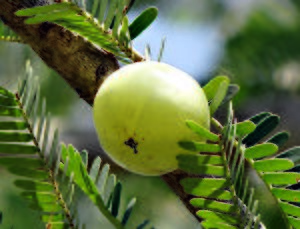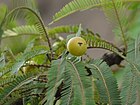Note: This is a project under development. The articles on this wiki are just being initiated and broadly incomplete. You can Help creating new pages.
Phyllanthus emblica - Emblic, Amalaki
Phyllanthus emblica tree is small to medium in size, reaching 1–8 m in height. The branchlets aren't glabrous or finely pubescent. It can grows up to 10–20 cm long.
Contents
- 1 Uses
- 2 Parts Used
- 3 Chemical Composition
- 4 Common names
- 5 Properties
- 6 Habit
- 7 Identification
- 8 List of Ayurvedic medicine in which the herb is used
- 9 Where to get the saplings
- 10 Mode of Propagation
- 11 How to plant/cultivate
- 12 Commonly seen growing in areas
- 13 Photo Gallery
- 14 References
- 15 External Links
Uses
Heart attack, Fast heartbeat, High blood presure, Migraine, Sheen of the hair, Immunomodulator, Daibetes, Aphrodisiac, Anaemia.
Parts Used
Bark, Seeds, Leaves, Fruits, Flowers.
Chemical Composition
Although these fruits are reputed to contain high amounts of ascorbic acid (vitamin C), up to 445 mg per 100 g, the specific contents are disputed, and the overall bitterness of amla may derive instead from its high density of ellagitannins.[1]
Common names
| Language | Common name |
|---|---|
| Kannada | Nellikayi |
| Hindi | Amla, Aonla |
| Malayalam | Embali, Amli |
| Tamil | Nellikkai, Nelli |
| Telugu | Usirika |
| Marathi | Anvala, Avalkathi |
| Gujarathi | Ambala, Amala |
| Punjabi | Aula, Amla |
| Kashmiri | Vasa |
| Sanskrit | Aamalaka, Amruthphala |
| English | Emblic Myrobalan |
Properties
Reference: Dravya - Substance, Rasa - Taste, Guna - Qualities, Veerya - Potency, Vipaka - Post-digesion effect, Karma - Pharmacological activity, Prabhava - Therepeutics.
Dravya
Rasa
Madhura (Sweet), Tikta (Bitter), Kashaya (Astringent), Katu (Pungent), Aamla
Guna
Laghu (Light), Ruksha (Dry)
Veerya
Sheeta (Cold)
Vipaka
Madhura
Karma
Tridoshajit, Vrishya, Rasaayana, Caksusya
Prabhava
Habit
Identification
Leaf
| Kind | Shape | Feature |
|---|---|---|
| Simple | Subsessile | The leaves are closely set along branchlets, light green, resembling pinnate leaves |
.[2]
Flower
| Type | Size | Color and composition | Stamen | More information |
|---|---|---|---|---|
| Unisexual | 2-6cm long | Greenish-yellow | Quite smooth and hard on appearance, with six vertical stripes or furrows. |
Fruit
| Type | Size | Mass | Appearance | Seeds | More information |
|---|---|---|---|---|---|
| Spherical | 2-6cm | Syncarp, Subglobose or ellipsoid with long echinate processes, orange when ripe | Single seed | {{{6}}} |
Other features
List of Ayurvedic medicine in which the herb is used
Where to get the saplings
Mode of Propagation
How to plant/cultivate
The light and medium heavy soils except prely sandy soil is ideal for amla cultivation.[3]
Commonly seen growing in areas
Photo Gallery
References
External Links
- Ayurvedic Herbs known to be helpful to treat Heart attack
- Ayurvedic Herbs known to be helpful to treat Fast heartbeat
- Ayurvedic Herbs known to be helpful to treat High blood presure
- Ayurvedic Herbs known to be helpful to treat Migraine
- Ayurvedic Herbs known to be helpful to treat Sheen of the hair
- Ayurvedic Herbs known to be helpful to treat Immunomodulator
- Ayurvedic Herbs known to be helpful to treat Daibetes
- Ayurvedic Herbs known to be helpful to treat Aphrodisiac
- Ayurvedic Herbs known to be helpful to treat Anaemia
- Herbs with Bark used in medicine
- Herbs with Seeds used in medicine
- Herbs with Leaves used in medicine
- Herbs with Fruits used in medicine
- Herbs with Flowers used in medicine
- Herbs with common name in Kannada
- Herbs with common name in Hindi
- Herbs with common name in Malayalam
- Herbs with common name in Tamil
- Herbs with common name in Telugu
- Herbs with common name in Marathi
- Herbs with common name in Gujarathi
- Herbs with common name in Punjabi
- Herbs with common name in Kashmiri
- Herbs with common name in Sanskrit
- Herbs with common name in English
- Habit - Tree
- Index of Plants which can be propagated by Seeds
- Index of Plants which can be propagated by Airlayers
- Herbs that are commonly seen in the region of Trophical area
- Herbs that are commonly seen in the region of Hill slop
- Herbs
- Ayurvedic herbs that don't have seed photos
- Phyllanthaceae





